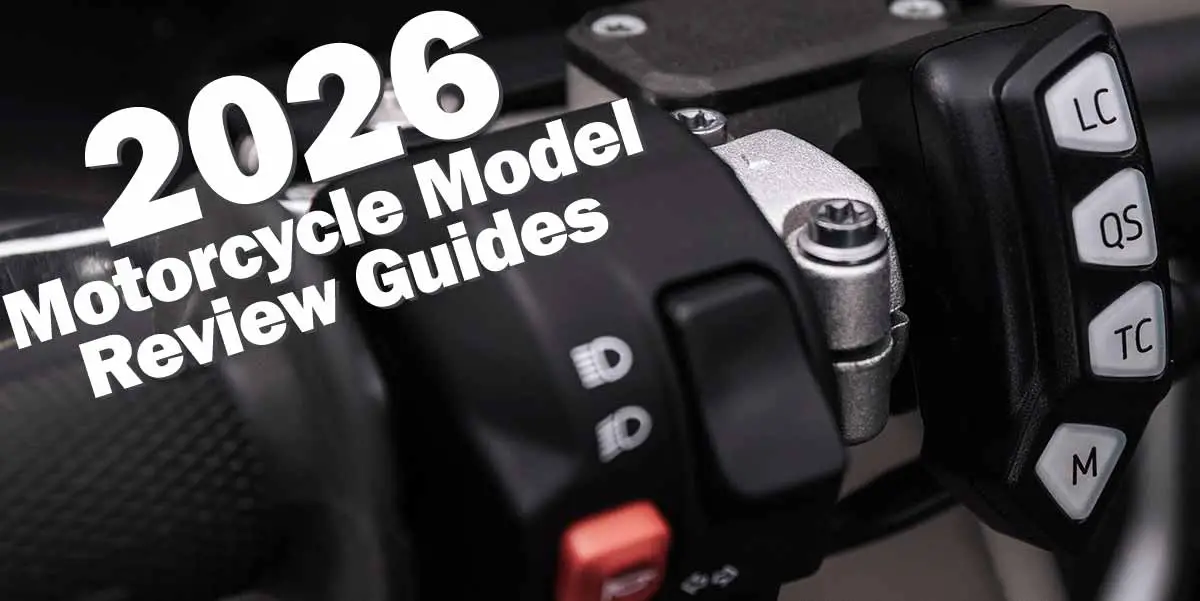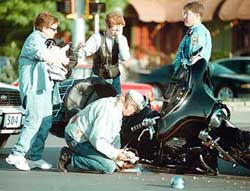
Section Nine: Survivability – Cars Versus Motorcycles
Cars are bigger, heavier, made of more metal, hit harder, have no brains and simply do not play fair. Cars versus motorcycles, an automatic defeat? Maybe not…
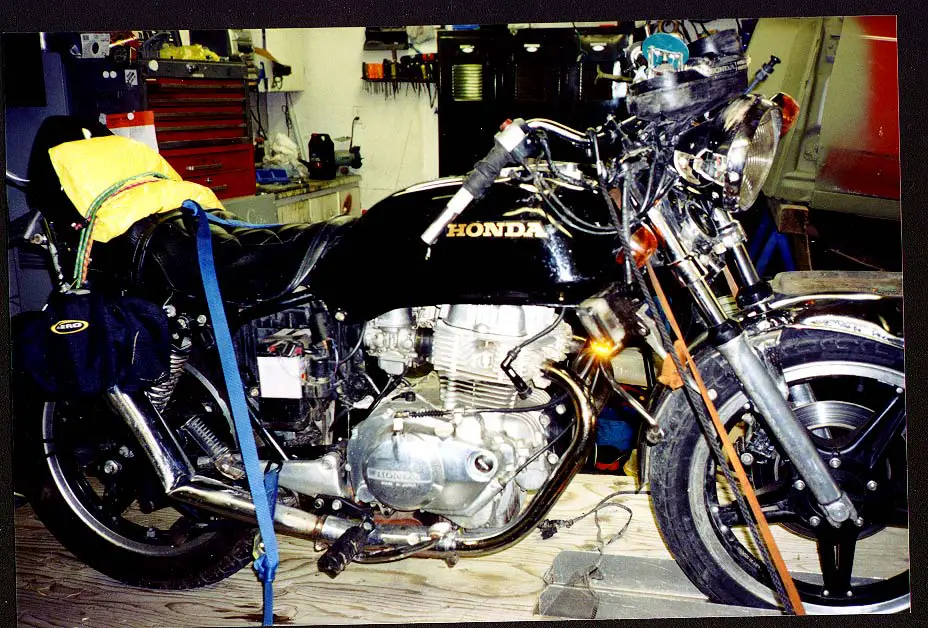
| Collision Between | Other Vehicle Fatalities | Motorcyclist Fatalities |
|---|---|---|
| Car & Motorcycle | 17 | 596 |
| Light Truck & Motorcycle | 0 | 396 |
| Large Truck & Motorcycle | 0 | 114 |
| Motorcycle & Motorcycle | n/a | 28 |
| Bus & Motorcycle | 0 | 7 |
| Other/Unknown & Motorcycle | 0 | 29 |
| Source: Bureau of Transportation Statistics, U.S. Fatalities, Two-vehicle Collisions, 1994 | ||
Sickening statistics, eh? They prove one point: don’t hit another vehicle (or a stationary object like a pole or building), because chances are you won’t win. As the saying goes: “When they meet, four wheels are frequently better than two. While the car’s driver is usually uninjured, the motorcyclist needs transportation to the hospital.”
So, what can we do as motorcyclists to avoid ending up in this situation? Since you don’t want to be hurt, injured, or worse, here’s what YOU can do about it.
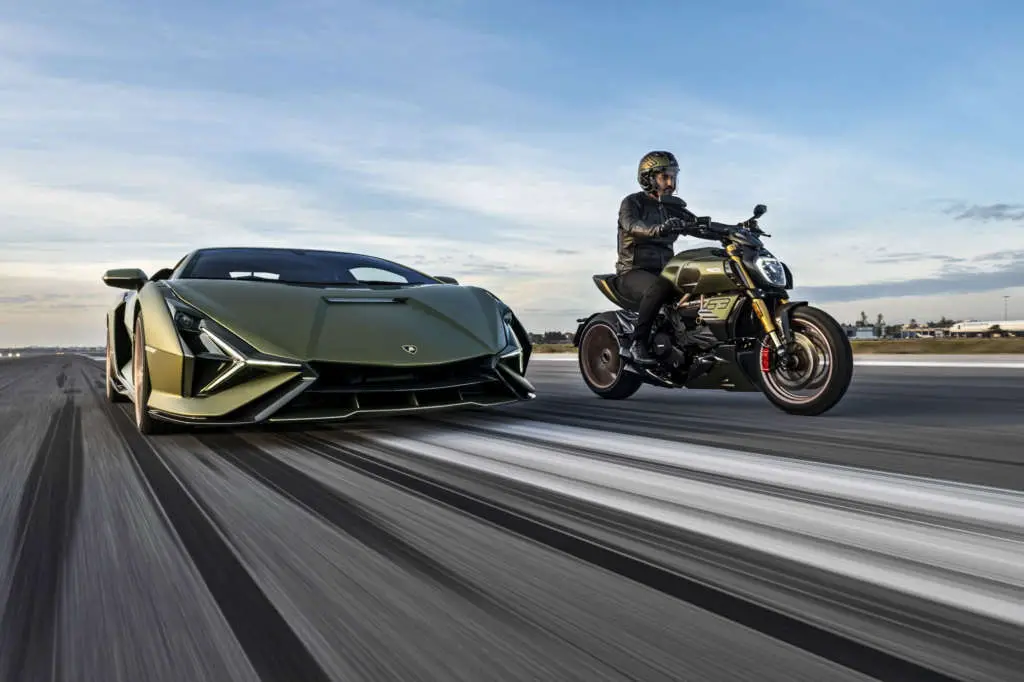
Survivability – Cars Versus Motorcycles
Motorcycles are small, lightweight, performance-oriented vehicles compared to cars and trucks. This gives them certain advantages and disadvantages in emergencies.
We’ve already looked at one major disadvantage: hitting something bigger and heavier than you. The solution? Don’t. Do everything you can to avoid hitting it. Sure, that sounds obvious, but the real question is: did you know and practice your motorcycle’s advantages? Did you use all of them when it mattered?
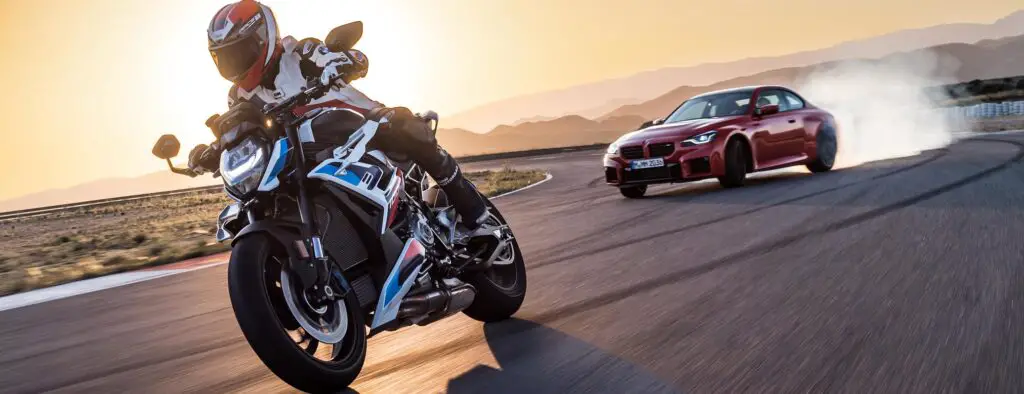
The Advantages of a Motorcycle (over other vehicles)
A famous expression goes: “There are two kinds of bikers, those who have been in an accident, and those about to be.” Don’t think of “accident” as always fatal, it can mean dropping your bike in the driveway or tipping at an intersection. Experience comes from mistakes, and mistakes are natural. The key is to learn from them.
I’ve been in two accidents myself. The first was my bike blown over by wind while parked on its center stand. The second was taking a curve too fast in a group ride. Both taught me valuable lessons: don’t park on soft soil in high winds, don’t get caught up in group mentality, slow down for blind curves, and always ride within your limits. Training is important, but practice makes it instinctive, you’ll always do what you’ve practiced.
Late Evening Reads
Required Reading for all Motorcyclists – What You Don’t Know Can Hurt You.

“The Hurt Report”
(Motorcycle Accident Cause Factors and Identification of Countermeasures)
This landmark study, conducted in 1981 by H.H. Hurt and colleagues at the University of Southern California, remains one of the most comprehensive examinations of motorcycle accidents ever undertaken. Below is a summary of its key findings. For the full report, contact the National Technical Information Service, Springfield, Virginia.
Summary of Findings
- Collision types: About 75% of accidents involved another vehicle, usually a passenger car. About 25% were single-vehicle crashes.
- Mechanical failure: Rare, less than 3% of cases, often due to tire punctures.
- Rider error: Present in two-thirds of single-vehicle accidents, often from over-braking or running wide in a curve.
- Roadway defects: Caused only 2% of accidents; animals just 1%.
- Right-of-way violations: In two-thirds of multi-vehicle crashes, the other driver violated the motorcyclist’s right-of-way.
- Visibility: Failure of motorists to detect motorcycles is the leading cause. Conspicuity (headlamps, bright clothing) significantly reduces risk.
- Intersections: The most common crash site, often involving a car turning left in front of a motorcycle.
- Weather: Not a factor in 98% of accidents.
- Trip type: Most accidents occurred on short, local trips near the origin point.
- Fuel hazards: Post-crash fuel leaks occurred in 62% of accidents, creating fire risk.
- Speeds: Median pre-crash speed was 29.8 mph; median crash speed 21.5 mph. Only 1 in 1000 crashes occurred above 86 mph.
- Rider demographics: Riders aged 16–24 were overrepresented; 30–50 underrepresented. 96% of riders were male, but female riders were statistically overrepresented.
- Training: 92% of riders were self-taught or learned informally. Formal training reduced both accident involvement and injury severity.
- Experience: Over half of riders had less than 5 months on the accident motorcycle, despite averaging 3 years of total riding experience.
- Alcohol: Involved in nearly half of fatal accidents.
- Collision avoidance: Many riders overused the rear brake, underused the front, and lacked countersteering/swerve skills. Riders typically had less than 2 seconds to react.
- Protective gear: Heavy boots, jackets, and gloves reduced abrasions. Helmets were the single most effective factor in preventing head injuries, with no evidence of impairing vision or hearing.
- Licensing: Many riders lacked proper motorcycle licenses or had revoked licenses.
- Injury likelihood: Extremely high, 98% of multi-vehicle and 96% of single-vehicle accidents resulted in injury; 45% were more than minor.
- Injury patterns: Lower extremities (ankle, leg, knee, thigh) were most often injured. Chest and head injuries were the most deadly.
- Motorcycle type: Large-displacement bikes were underrepresented in crashes but had higher injury severity when involved.
- Modifications: Semi-choppers and café racers were overrepresented in accidents.
The Hurt Report – 55 Key Findings
A quick-reference table summarizing all findings from the landmark 1981 study on motorcycle accidents.
| # | Finding |
|---|---|
| 1 | Approximately three-fourths of motorcycle accidents involved collision with another vehicle, most often a passenger automobile. |
| 2 | Approximately one-fourth of motorcycle accidents were single-vehicle crashes involving the roadway or a fixed object. |
| 3 | Vehicle failure accounted for less than 3% of accidents, mostly puncture flats. |
| 4 | In single-vehicle accidents, rider error was present in about two-thirds, typically over-braking or running wide in a curve. |
| 5 | Roadway defects caused 2% of accidents; animals caused 1%. |
| 6 | In multi-vehicle accidents, the other driver violated the motorcycle’s right-of-way in two-thirds of cases. |
| 7 | Failure of motorists to detect motorcycles is the predominant cause of collisions. |
| 8 | Deliberate hostile action by motorists is rare; the most frequent scenario is a car turning left in front of a motorcycle. |
| 9 | Intersections are the most likely place for accidents, often with right-of-way violations. |
| 10 | Weather is not a factor in 98% of motorcycle accidents. |
| 11 | Most accidents involve short trips near the origin point. |
| 12 | In almost half of multi-vehicle accidents, the motorcycle was obscured by glare or other vehicles. |
| 13 | Conspicuity is critical; daytime headlamps and high-visibility clothing reduce accidents. |
| 14 | Fuel leaks/spills occurred in 62% of accidents post-crash, creating fire hazards. |
| 15 | Median pre-crash speed was 29.8 mph; median crash speed 21.5 mph; 1-in-1000 crashes occurred above 86 mph. |
| 16 | Most hazards were within 45° of straight ahead; peripheral vision was not a limiting factor. |
| 17 | Conspicuity is most critical for frontal surfaces of rider and motorcycle. |
| 18 | Vehicle defects are rare and usually due to poor maintenance. |
| 19 | Riders aged 16–24 are overrepresented; riders 30–50 underrepresented. Female riders are statistically overrepresented. |
| 20 | Laborers, students, and unemployed riders are overrepresented; professionals and sales workers underrepresented. |
| 21 | Riders with prior citations/accidents are overrepresented. |
| 22 | 92% of riders were self-taught or learned informally; formal training reduces accidents and injuries. |
| 23 | Over half of riders had less than 5 months on the accident motorcycle, despite averaging 3 years’ total experience. |
| 24 | Riders with dirt bike experience are underrepresented in accidents. |
| 25 | Lack of attention is a common factor for riders in accidents. |
| 26 | Alcohol was involved in almost half of fatal accidents. |
| 27 | Riders showed significant collision avoidance problems: over-braking rear, under-braking front, poor countersteering. |
| 28 | Riders typically had less than 2 seconds to complete collision avoidance. |
| 29 | Passenger-carrying motorcycles are not overrepresented in accidents. |
| 30 | Drivers of other vehicles in collisions were often aged 20–29 or over 65, and generally unfamiliar with motorcycles. |
| 31 | Large-displacement motorcycles are underrepresented in crashes but associated with higher injury severity. |
| 32 | Motorcycle color had no determinable effect on accident involvement. |
| 33 | Motorcycles with fairings/windshields are underrepresented in accidents, likely due to conspicuity and experienced riders. |
| 34 | Many riders lacked proper motorcycle licenses or had revoked licenses. |
| 35 | Modified motorcycles (semi-choppers, café racers) are overrepresented in accidents. |
| 36 | Injury likelihood is extremely high: 98% of multi-vehicle and 96% of single-vehicle accidents resulted in injury. |
| 37 | Lower extremities (ankle, leg, knee, thigh) are the most frequently injured body regions. |
| 38 | Crash bars are not effective; they reduce ankle injuries but increase thigh/knee/leg injuries. |
| 39 | Protective gear (boots, jackets, gloves) reduces abrasions and lacerations. |
| 40 | Groin injuries occurred in at least 13% of accidents, often in frontal impacts at higher speeds. |
| 41 | Injury severity increases with speed, alcohol involvement, and motorcycle size. |
| 42 | 73% of riders used no eye protection; wind likely impaired vision and delayed hazard detection. |
| 43 | About 50% of riders in traffic wore helmets, but only 40% of accident-involved riders did. |
| 44 | Helmet use was lowest among untrained, uneducated, young riders on hot days and short trips. |
| 45 | Head and chest injuries were the most deadly. |
| 46 | Helmet use is the single most critical factor in preventing head injury; FMVSS 218 helmets are highly effective. |
| # | Finding |
|---|---|
| 47 | FMVSS 218 provides a high level of protection in traffic accidents, but needs modification to increase coverage at the back of the head, demonstrate impact protection of the front of full-face helmets, and ensure all adult sizes are covered. |
| 48 | Helmeted riders and passengers showed significantly lower head and neck injury rates for all types and severities of injury. |
| 49 | Full-face helmets increase protection and significantly reduce facial injuries. |
| 50 | There is no liability for neck injury from helmet use; helmeted riders actually had fewer neck injuries than unhelmeted riders. Only four minor injuries were attributable to helmet use, and in each case the helmet prevented a more serious injury. |
| 51 | 60% of motorcyclists were not wearing helmets at the time of the accident. Of these, 26% said helmets were uncomfortable/inconvenient, and 53% said they had no expectation of accident involvement. |
| 52 | Valid motorcycle exposure data can only be obtained from traffic site collection; license or registration data is unrelated to actual use. |
| 53 | Less than 10% of accident-involved riders had any insurance to provide medical care or replace property. |
| 54 | Helmet use is the single most critical factor in preventing or reducing head injury; helmets meeting FMVSS 218 are highly effective. |
| 55 | Safety helmet use caused no reduction in hearing, no limitation of pre-crash visual field, and no fatigue or loss of attention. No element of accident causation was related to helmet use. |
Top 10 Key Findings from the Hurt Report
A quick-reference table highlighting the most important insights from the landmark 1981 study on motorcycle accidents.
| # | Key Finding |
|---|---|
| 1 | 75% of motorcycle accidents involve another vehicle, most often a passenger car. |
| 2 | In two-thirds of multi-vehicle crashes, the other driver violated the motorcyclist’s right-of-way. |
| 3 | Failure of motorists to detect motorcycles is the leading cause of collisions. |
| 4 | Conspicuity matters: daytime headlamps and high-visibility clothing significantly reduce accidents. |
| 5 | Rider error (over-braking, running wide in curves) is a major factor in single-vehicle crashes. |
| 6 | Alcohol is involved in nearly half of fatal motorcycle accidents. |
| 7 | Protective gear (helmets, boots, jackets, gloves) greatly reduces injury severity. |
| 8 | Helmet use is the single most effective factor in preventing head injuries, with no evidence of impairing vision or hearing. |
| 9 | Most riders in accidents lacked formal training; 92% were self-taught or learned informally. |
| 10 | Riders typically have less than 2 seconds to complete all collision-avoidance actions. |
A Rider’s Story: The Cost of No Helmet
The second time I awoke, I was on my back in the emergency room with a brace around my neck, a white sheet over my body, and in pain like I’d never felt before. I had road rash on both arms, legs, and on the small of my back. I had a three-inch cut on my forehead, a two-inch cut on the top of my head, and my right ear was nearly ripped off.
I hadn’t worn a helmet.
All of my head wounds needed stitches or staples. At the time I still was unsure how badly I’d hurt myself. As I lay in the ER while the doctors worked on me, I never felt so alone and scared in my life. My wife and son were out of town visiting her family.
I couldn’t believe what I’d done to myself. I prided myself on being an excellent motorcyclist. But during the days of my recovery, I realized that it didn’t matter how well I could ride a motorcycle. If I had no self-control, I was bound to hurt myself and those around me. I knew if I were to ever get back on a motorcycle, I had a lot of growing up to do.
I know that riding impaired and not riding with the proper protective equipment is dangerous and is the quickest way to personal injury and death. I’m extremely lucky to be alive today to share my story.
I wish that I could turn back the clock and do things differently, but I can’t. I can only beg those that I come in contact with to learn from my mistakes. Be responsible, and use good judgment and self-control. If you’re not in sound mind and body, you shouldn’t be in a car or on a motorcycle.
— Staff Sgt. Eric D. Folks, Little Rock Air Force Base, Ark.



